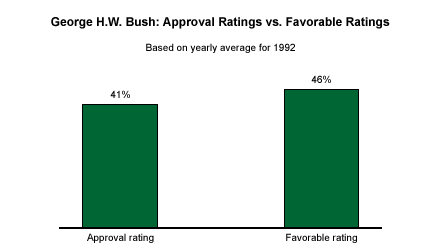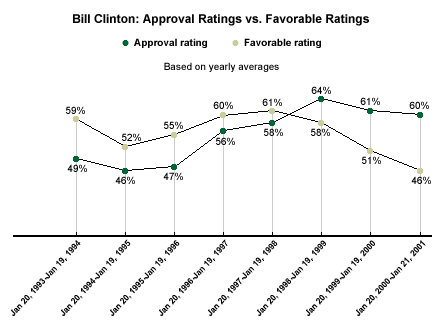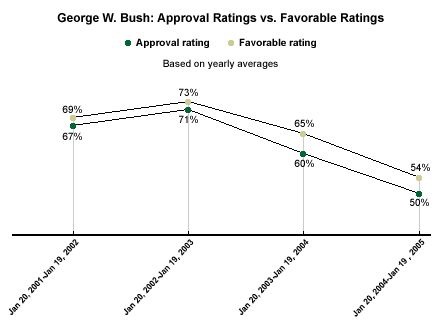How do presidents' job approval ratings match up with their favorability ratings? A review of Gallup polling* suggests that presidents are usually rated more highly on a personal level than for their job performance.
Gallup finds that the percentage of Americans who rated former President George H.W. Bush and current President George W. Bush favorably was just slightly higher than the percentage who approved of the way they handled their jobs. The same pattern holds true for Bill Clinton's first term in office, but not for his second term. Because of the Monica Lewinsky scandal that rocked Clinton's second term, his favorability ratings plummeted in his last years in office, while his job approval ratings improved and held steady.
It is important to note that while Gallup has tracked presidential approval ratings since the 1930s, it has only more recently asked Americans whether they have a favorable or unfavorable opinion of presidents and other people in the news (prior to asking the current form of the question, respondents were asked to rate basic opinions of presidents and other prominent people on a 10-point scale). This analysis is based on quarterly and yearly averages of these ratings over the past three administrations.
George H.W. Bush
In the elder Bush's final year in office (when Gallup first asked the current version of the favorability question), his favorable ratings were slightly higher than his approval ratings, by 46% to 41%, respectively.

A more detailed look at the 1992 data shows that Bush's favorable ratings were higher than his approval ratings in the first three quarters of the year, differing by seven percentage points in the first quarter and by eight points in the second and third quarters. In the last quarter, Bush's approval rating (49%) and favorable rating (48%) were essentially the same.
|
George H.W. Bush: Approval Ratings vs.
Favorable Ratings |
|||
|
Approval |
Favorable |
Difference |
|
|
% |
% |
|
|
|
Jan 20-Apr 19, 1992 |
42 |
49 |
-7 |
|
Apr 20-Jul 19, 1992 |
39 |
47 |
-8 |
|
Jul 20-Oct 19, 1992 |
35 |
43 |
-8 |
|
Oct 20, 1992-Jan 19, 1993 |
49 |
48 |
+1 |
An interesting pattern developed throughout 1992 for Bush's approval ratings and favorable ratings. Both ratings showed little change from the first to second quarter, then both dropped slightly in the third quarter, before improving in the fourth quarter. The ratings worsened in the summer and early fall during the 1992 presidential election campaign and improved in Bush's final months in office following his defeat against Clinton. Bush's approval ratings were higher in the fourth quarter than at any other time that year, while his fourth-quarter favorable ratings rebounded to levels found in the first half of the year.
Bill Clinton
The pattern of differences between Clinton's favorability ratings and his job approval ratings changed significantly between his first term and his second term.
In his first term, Clinton's favorable ratings exceeded his job approval ratings each year. During his first year, his favorable ratings averaged 10 percentage points higher than his approval ratings. By his fourth year in office, the two measures differed only by four percentage points, thanks to a higher average job approval rating that year.

During the first full year of Clinton's second term, his favorable ratings were again higher than his approval ratings, but only by a slim three-point margin.
Then, things began to change. Over the course of his final three years in office, undoubtedly resulting from the impeachment proceedings and the revelations of his relationship with Lewinsky, Clinton's favorable ratings began a steady, gradual decline, shifting from a high of 61% in the first year of his second term to a low of 46% in his last year. His approval ratings, however, edged up slightly in 1998 and held steady in 1999 and 2000, as the economy boomed and the public rallied around the beleaguered president.
A review of Clinton's quarterly averages on these measures show that Clinton's highest favorable rating (65%) occurred during the first quarter of his entire administration, while his highest approval rating came during the height of the impeachment process, with 66% approving of Clinton's job performance during the last quarter of the second year of his second term.
Clinton's lowest quarterly favorable rating was at the end of his second term, with 45% measures both in late 1999/early 2000 and in July to October 2000. His lowest quarterly approval rating was measured relatively early in his first term, with a 41% approval in July to October 1994.
George W. Bush
The current President Bush's approval and favorability ratings were similar during his first two years in office, with his favorable rating just slightly higher than his approval rating. In his first year in office, 69% of Americans viewed the president favorably, while 67% approved of his job performance. The next year, 73% rated Bush favorably, and 71% approved of him. Over the past two years, as both ratings have dropped significantly, the gap between his favorable and approval ratings has increased, with a five-point difference in favorable over approval in 2003 and a four-point difference last year.

Bush's highest quarterly approval rating and quarterly favorable rating occurred in last quarter of 2001, in the immediate months following the 9/11 attacks. At that time, Bush's approval rating was 86%, and his favorable rating was 85%.
Bush's lowest quarterly ratings occurred this past spring, when 48% of Americans approved of Bush and 52% had a favorable opinion of him.
|
George W. Bush: Approval Ratings vs.
Favorable Ratings |
|||
|
Approval |
Favorable |
Difference |
|
|
% |
% |
|
|
|
Jan 20-Apr 19, 2001 |
58 |
66 |
-8 |
|
Apr 20-Jul 19, 2001 |
56 |
64 |
-8 |
|
Jul 20-Oct 19, 2001 |
68 |
60 |
8 |
|
Oct 20, 2001-Jan 19, 2002 |
86 |
85 |
+1 |
|
Jan 20-Apr 19, 2002 |
80 |
N/A |
N/A |
|
Apr 20-Jul 19, 2002 |
75 |
80 |
-5 |
|
Jul 20-Oct 19, 2002 |
68 |
71 |
-3 |
|
Oct 20, 2002-Jan 19, 2003 |
64 |
68 |
-4 |
|
Jan 20-Apr 19, 2003 |
63 |
68 |
-5 |
|
Apr 20-Jul 19, 2003 |
64 |
66 |
-2 |
|
Jul 20-Oct 19, 2003 |
56 |
60 |
-4 |
|
Oct 20, 2003-Jan 19, 2004 |
55 |
65 |
-10 |
|
Jan 20-Apr 19, 2004 |
51 |
55 |
-4 |
|
Apr 20-Jul 19, 2004 |
48 |
52 |
-4 |
|
Jul 20-Oct 19, 2004 |
50 |
54 |
-4 |
|
Oct 20, 2004-Jan 19, 2005 |
52 |
55 |
-3 |
*These results are based on telephone interviews with randomly selected national samples of approximately 1,000 adults each, aged 18 and older, conducted January 1992 to January 2005. For results based on these samples, one can say with 95% confidence that the maximum error attributable to sampling and other random effects is ±3 percentage points. In addition to sampling error, question wording and practical difficulties in conducting surveys can introduce error or bias into the findings of public opinion polls.
